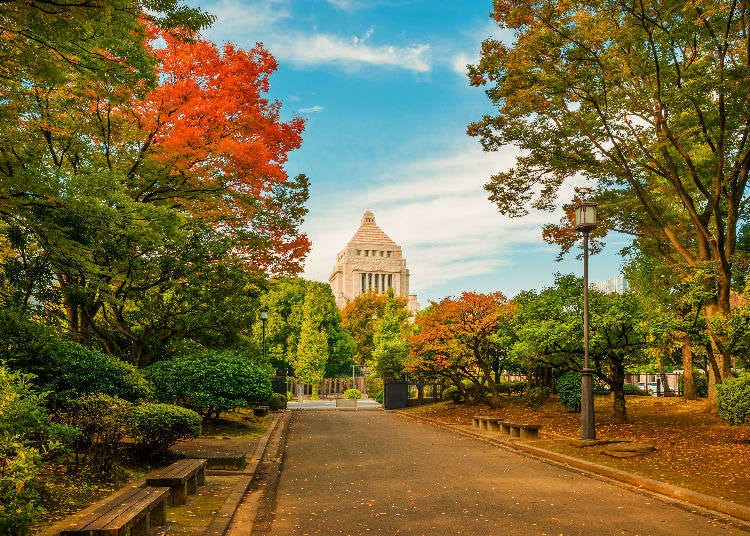
As with other capital cities, Tokyo has a variety of impressive government buildings that are open to the public. Tokyo’s National Diet Building finished its construction in 1936, becoming the main venue of Japanese politics and government. Standing in front of it, you see the House of Representatives on the left and the House of Councillors on the right. Both are open for tourists and you simply can spontaneously come by and sign up for a free tour! Let’s see what awaits behind the doors of the National Diet Building!
Visit the House of Representatives on Every Day; the House of Councillors on Weekdays
First of all, it is important to know when each house is open to the public, what kind of tours are available, and so on!
House of Representatives
English tours are available with an advance reservation (up to 1 day before your desired tour date) via email. Tours in Japanese take place every day and can be joined spontaneously. An English pamphlet is available.
English tours: Mondays (at 2:00 p.m.), Tuesdays, Wednesdays, Thursdays, and Fridays (3:00 p.m.)
Japanese tours: Monday to Friday - every hour at half past between 8:00 a.m. and 5:00 p.m. (last admission at 4:00 p.m.) / Saturdays, Sundays and national holidays – six tours a day, at 9:30 a.m., 10:30 a.m., 11:30 a.m., 1:00 p.m., 2:00 p.m., 5:00 p.m.
For more information, have a look at the official website: http://www.shugiin.go.jp/internet/itdb_english.nsf/html/statics/guide/tours.htm.
House of Councillors
There is no English tour available, but visitors can join the Japanese tours and get an English booklet. This tour does not require a reservation.
Japanese tours: Monday to Friday – every hour from 9:00 a.m. to 4:00 p.m.
However, neither building can be visited one hour before a plenary session is held. Tours resume once the session is over. Each tour takes about an hour, accompanied by guards of the parliament, and follows a fixed route. Taking pictures is allowed only at designated spots, videos are banned altogether.
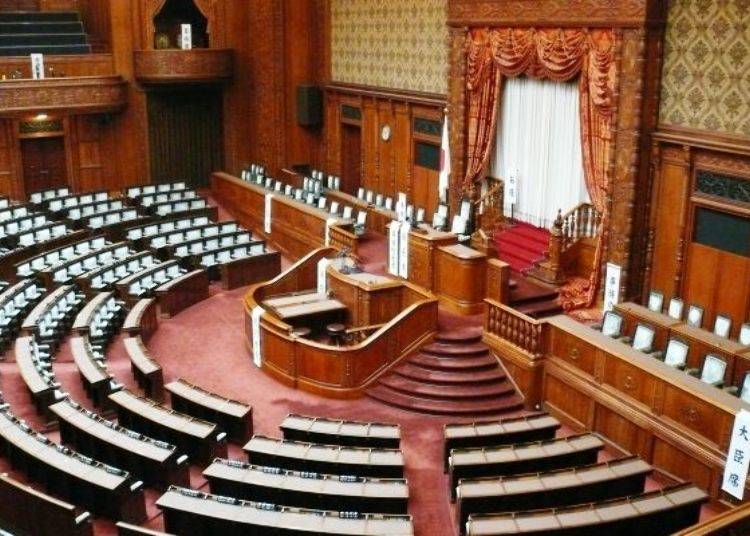
Since we want to introduce you to both houses in this article, we asked for a special permission to take more pictures than allowed on a regular tour. The House of Councillors gave us the OK. Accompanied by a spokesperson, we’ll show you certain things that regular visitors don’t get to see, even if the tour course is the same.
Unfortunately, the House of Representatives denied our request. In the Japanese system of two houses, the decisions of the House of Representatives is seen as the superior one and its decisions are weighed more heavily, so the public has a higher interest in it. Taking that into consideration, it is natural that the House of Representatives is tough when it comes to security matters. However, since the general public can visit the place without issues, we decided to focus on the House of Councillors.
By the way: the House of Councillors has the role of “complementing, checking, and balancing” the House of Representatives, which is why it is also known as the “chamber of wisdom.”
Surprisingly High-Tech: the House of Councillors
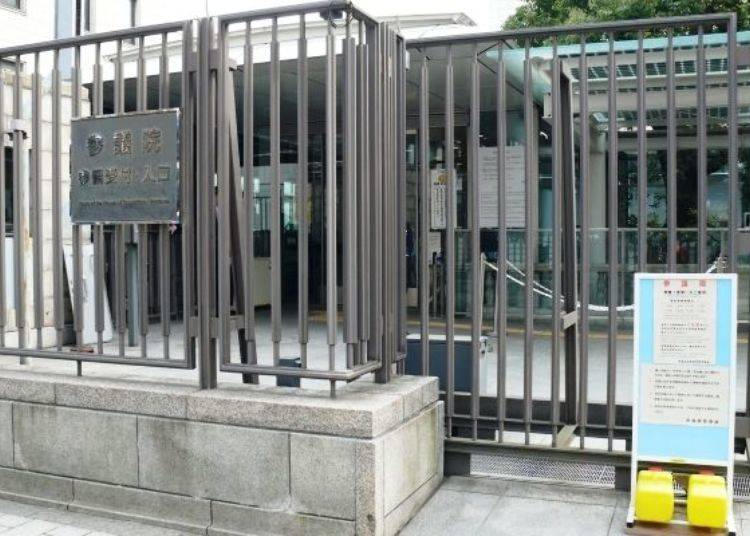
The entrance to the House of Councillors is located on the back (west side) of the building. Simply write your name and address at the reception and go down to the “visitor’s lobby” on the first basement floor. Here’s where people wait for the tour to start, but the room is filled with interesting exhibits teaching the basics about the building and institution.
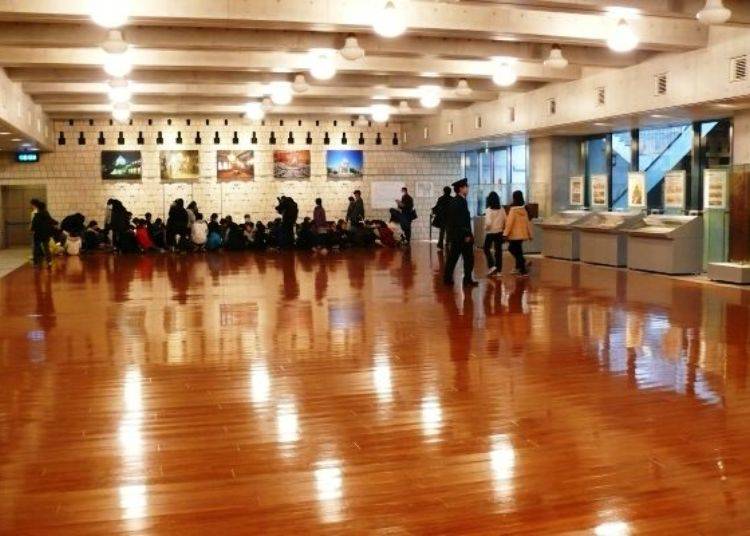
One of the exhibits is, for example, a model of the National Diet Building, giving you a great overview of the building you’re about to tour. To put it simply, the complex is symmetrical with the white central tower in the center. On the right side is the main chamber of the House of Councillors, bordering the courtyard, and the main chamber of the House of Representatives is on the left.
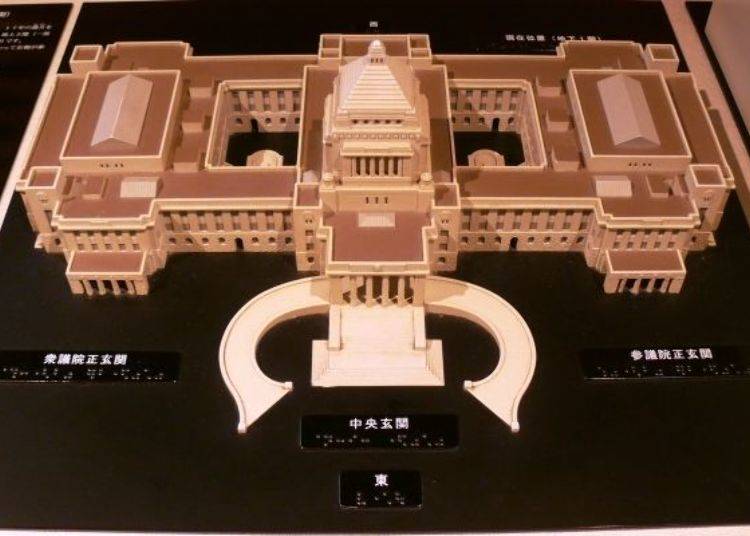
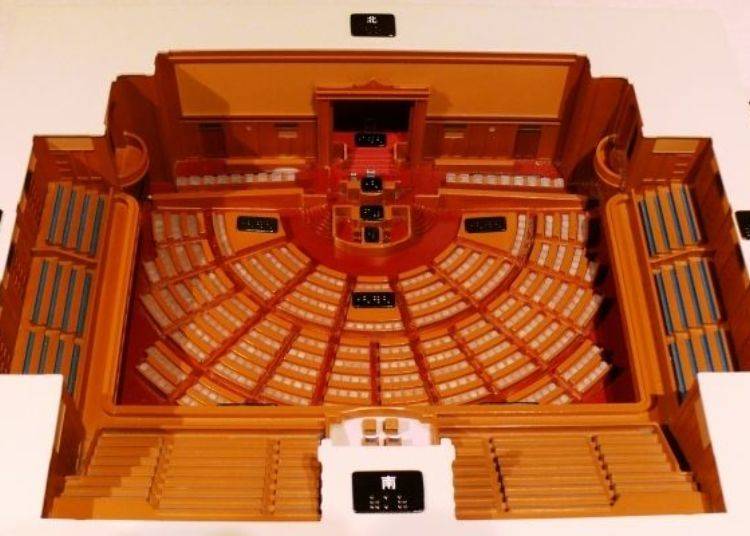
There even is a replica seat of a Diet member that you can actually sit on (and, of course, we had to try). The backrest is at an angle of 90°, naturally straightening the spine. A black nameplate marks whose seat it is. From time to time, a lawmaker stands up and knocks it down with a clatter. Actual diet seats record a member’s attendance by whether this nameplate is standing on the table. We were tempted to knock it over but barely resisted the urge.
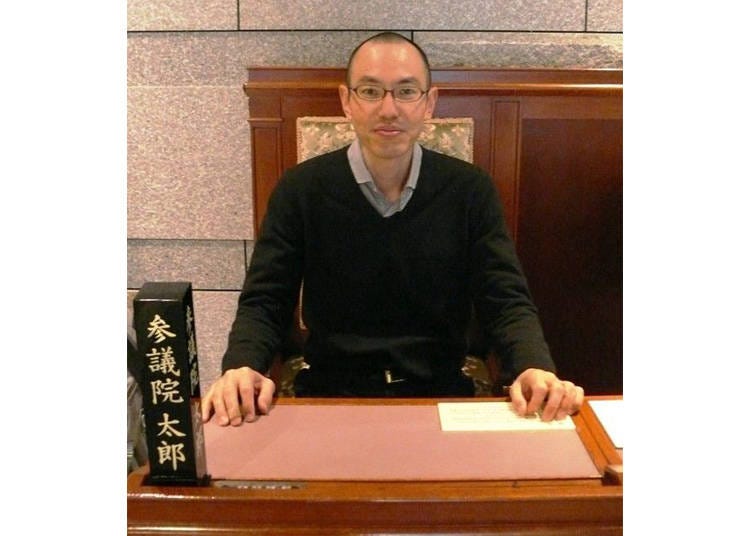
Putting the nameplate in an upright position reveals the voting buttons. There mainly is a “standing vote” and an “open ballot” when it comes to the voting process of both houses. In the House of Councillors, these buttons are installed since 1998 – the institution is surprisingly high-tech.
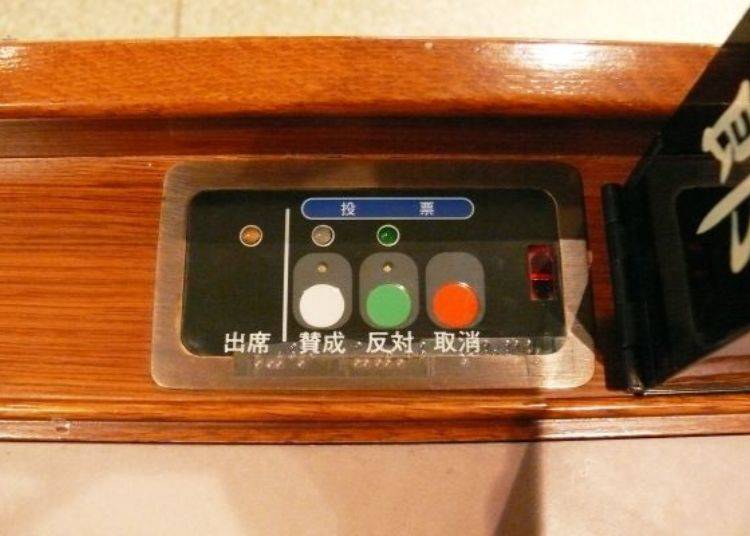

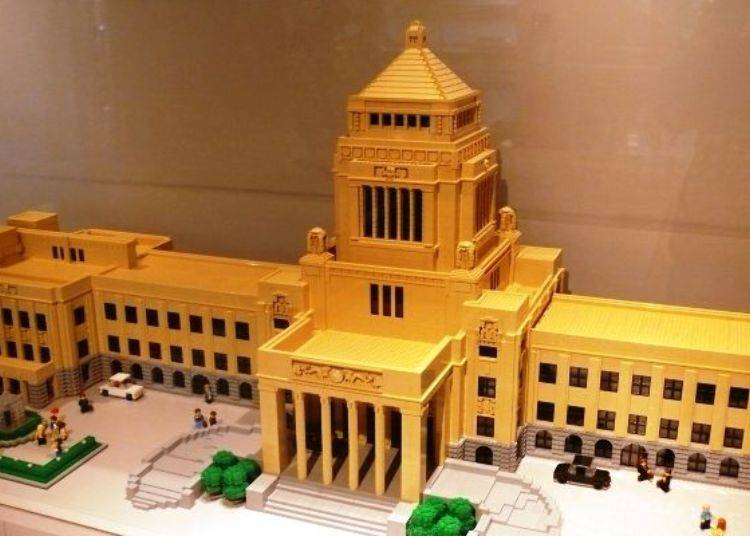
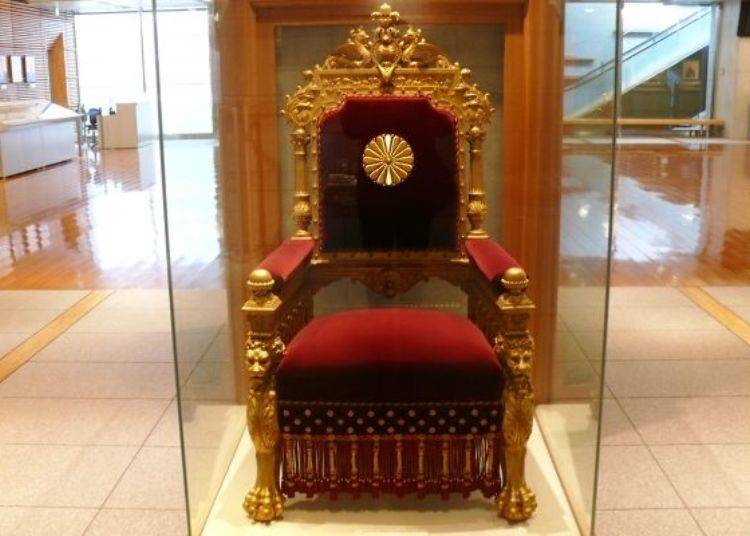
The Chamber of House of Councillors, also Called the “Theater”
After the bag inspection in the visitor’s lobby, the headed up the stairs to the Chamber of the House of Councillors. The seats for visitors and spectators are on the third floor. As soon as the doors are opened, the “theater” spreads in front of your eyes – it’s a real spectacle.
The “stage” is made up of the chairman’s seat in the center and the seats of the ministers of state to the left and right; the surrounding seats of the diet members look like spectator’s. Even though the room is empty, it has an air of a discussion that is just about to begin.
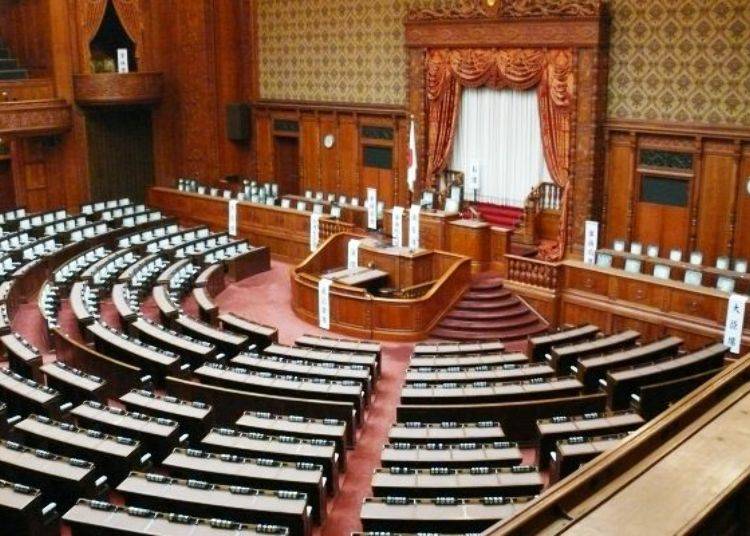
Behind the curtain of the chairman’s seat is where the Emperor sits during the opening ceremony of the National Diet. This ceremony is always held at the House of Councillors, meaning that the chamber of the House of Representatives doesn’t have such an area. Instead, the Emperor has a listener’s seat above the chairman’s seat.
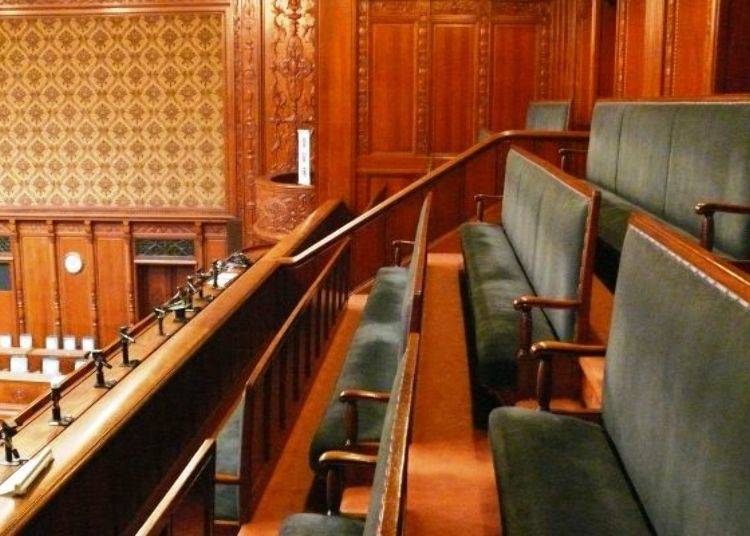

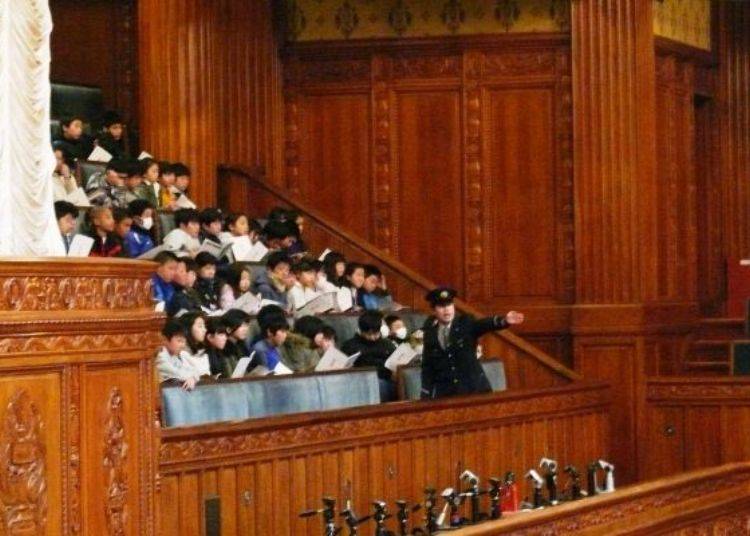
The ceiling is adorned with beautiful stained-glass art. Generally, the National Diet Building is entirely made from domestic building materials, with only three exceptions. One of them is this stained glass, which was processed in Japan but the glass itself was imported from the United States and the United Kingdom.
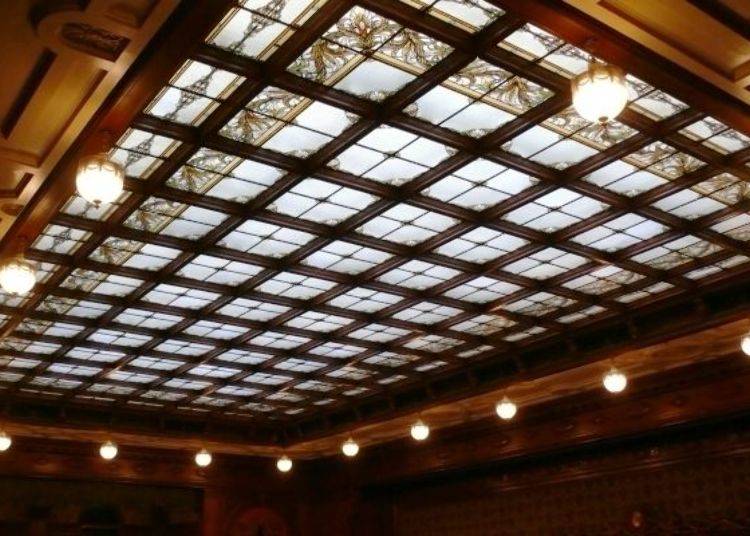
Walking on the Famous Red Carpet
Leaving the chamber of the House of Councillors features its own little highlight: the door. Its knob is the second import, coming from the United States.
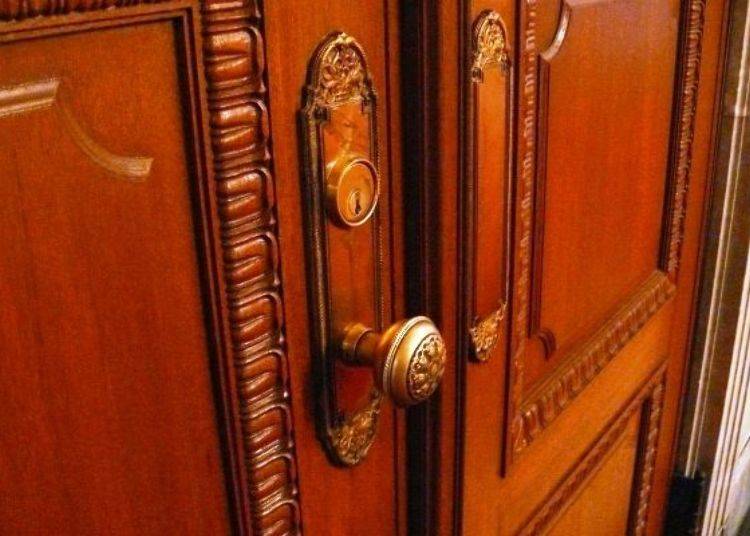
And the third imported element is the letterbox attached to the wall of the hallway, which is also from the States. Any mail that goes in here falls to the basement and is collected by the postal staff. That’s why you’ll find this letterbox at the same exact position on every floor.
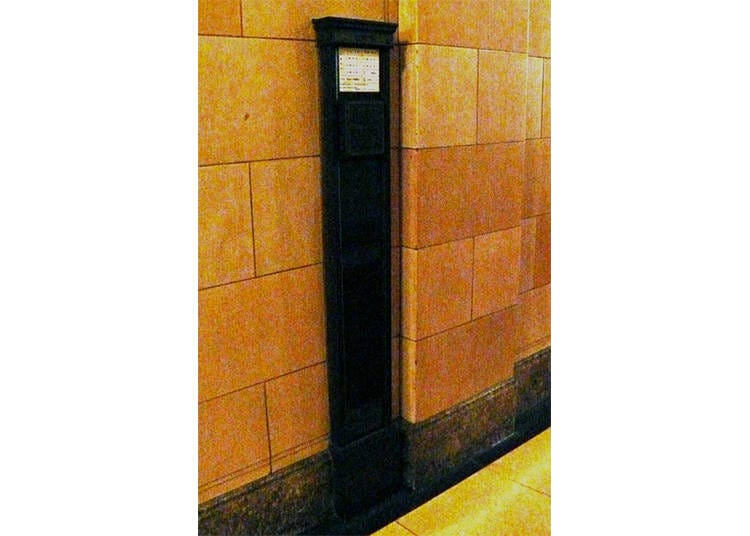
The carpets of the National Diet Building are all called “red carpets,” but they’re actually somewhat pink instead of bright red. The color’s name is “royal red,” apparently. We were surprised to see that it has a deep red border. The design creates a calm and elegant color and since we rarely get the chance to walk on a red carpet like that, we made sure to strut all over it.
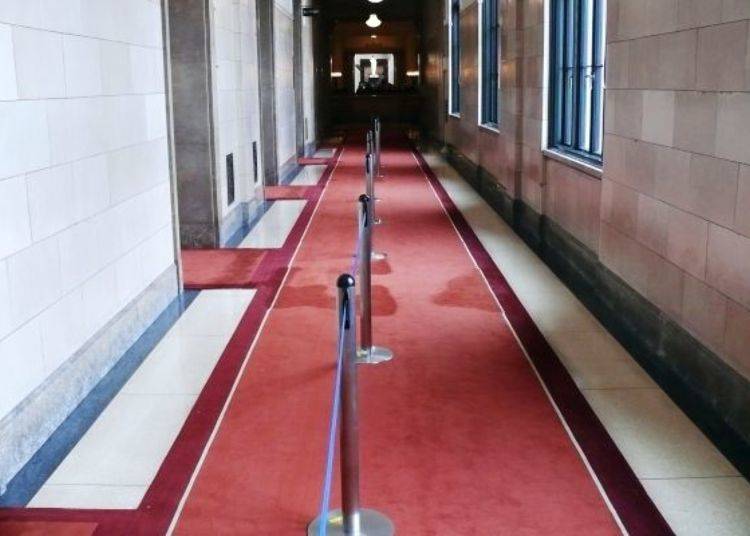
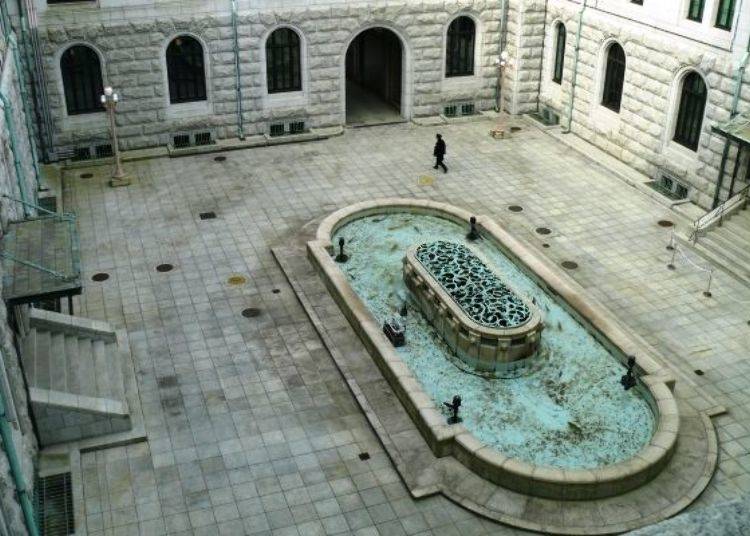
The central part of the fountain is a ventilation hatch. Air conditioning hadn’t been invented yet when the building was constructed, so fresh air got into the building via this hatch. According to rumors, the horses of diet members arriving via carriage were watered here, but there are no documents that support this claim.
Around the ventilation hatch is 18 lion fountains that all have different faces. Their unique expressions represent the diversity of the will of the people.
Who Sits in the Empty Chair?
As you continue through the corridor, you’ll find yourself in the central part that is used by both Houses. On the third floor is a resting room for the Emperor. It’s the most luxurious space in the entire complex and about 10% of the entire construction building went into this room. We get to see it through the glass.
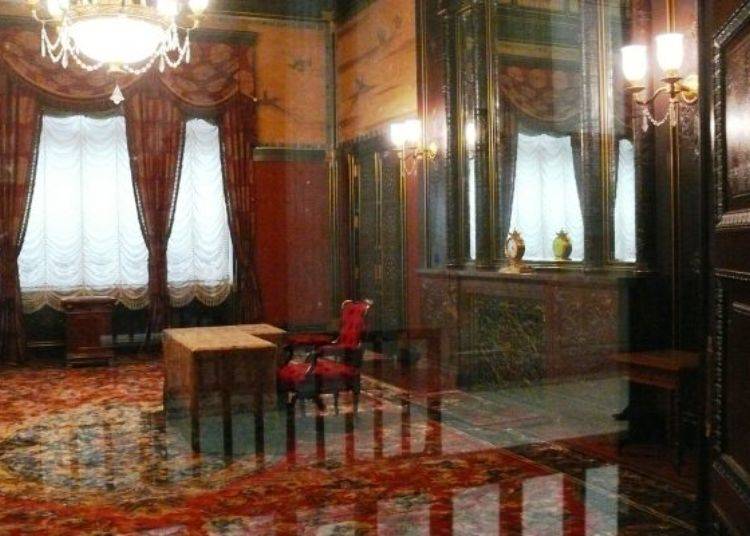

Go further and you get to the Central Hall.
If you look down to the second floor from the balcony, you can spot three statues. They’re Hirobumi Itō, Taisuke Itagaki, and Shigenobu Ōkuma, the great men who majorly contributed to Japan’s parliamentary politics. In a blind spot from the observation place stands an empty chair in a corner and there are several theories regarding its meaning, such as “people couldn’t decide who to make into a fourth statue,” or “a symbol that politics is never complete.” Will this spot ever be filled by someone?
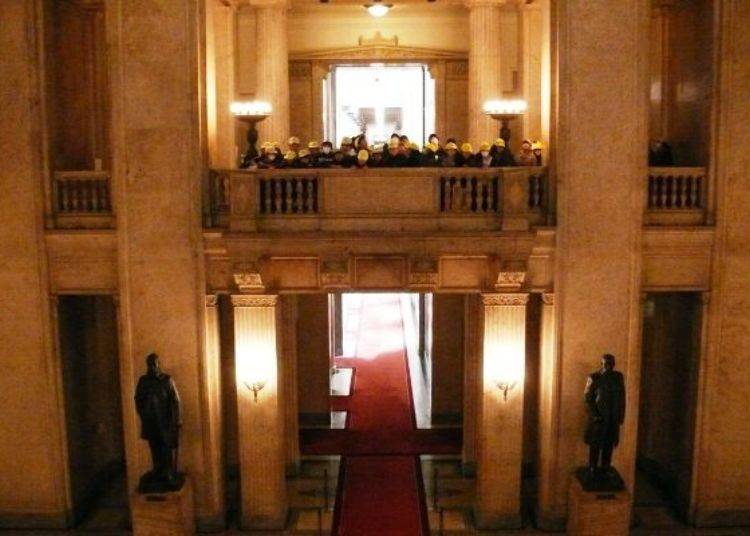

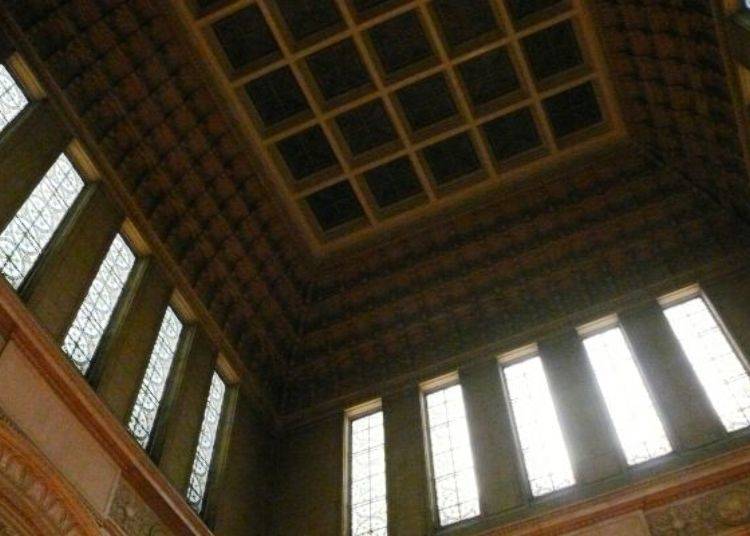
Take a Commemorative Photo at the Front Gate
That concludes the tour of the Chamber of Councillors at the National Diet Building. Now all that’s left to do is to go out to the front yard through the courtyard and enjoy the tree-lined promenade. Turn around to get a stunning view of the majestic Central Entrance of the historic building – it’s a fantastic spot for a commemorative picture. We asked the friendly guard to take one for us.
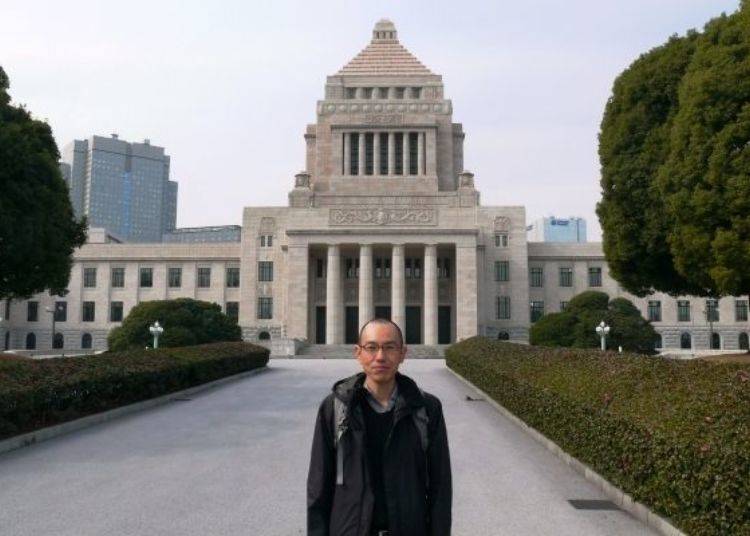
The highlight of the visit was the Chamber of the House of Councillors. While you can easily get a glimpse of it on TV and photos, standing inside the large room in person is a wholly different – and warmly recommended – experience. You might find yourself suddenly overcome by the urge to give a speech...
-

-
Address
1-7-1, Nagatacho, Chiyoda-ku, Tokyo, 100-0014
View Map -
Nearest Station
Nagatacho Station (Tokyo Metro Yurakucho Line / Tokyo Metro Hanzomon Line / Tokyo Metro Namboku Line)
3 minutes on foot
- Phone Number 03-3581-3100
-
Address
1-7-1, Nagatacho, Chiyoda-ku, Tokyo, 100-0014
The Exciting and Tense House of Representatives
Let’s return to the building once more to visit the House of Representatives. It’s a shame that we cannot show you pictures because the main chamber is quite different from the one in the House of Councillors. The Emperor’s seat is on a balcony over the chairman’s seat, an intriguing detail that people don’t tend to notice when merely looking at a TV broadcast or picture.
A committee session (held to discuss topics outside of the main plenary sessions) took place on the third floor and reporters waited in front of the doors. There was a feeling of tension in the air – the good kind, though. The kind that signals that the government is working as it should.
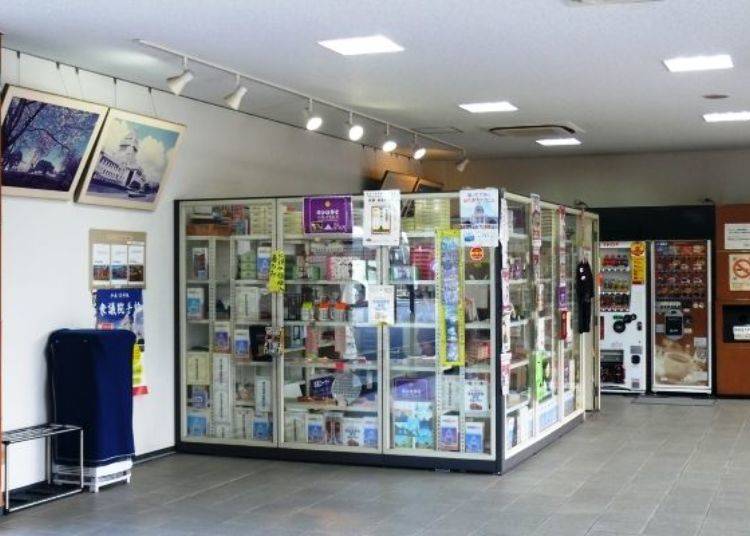
Same as the House of Councillors, there is a group bus parking lot next to the National Diet Library. Simply leave the main gate and head to the left and you’ll find a shop there, selling various domestic goods. The highlight is the many goodies that feature prominent Japanese politicians, such as “Abe’s Mixed Vegetable Chips” (referencing Prime Minister Shinzo Abe) and “Shin-chan’s Happy Selection” (referencing Shinjirō Koizumi, politician and son of former Prime Minister Junichirō Koizumi).
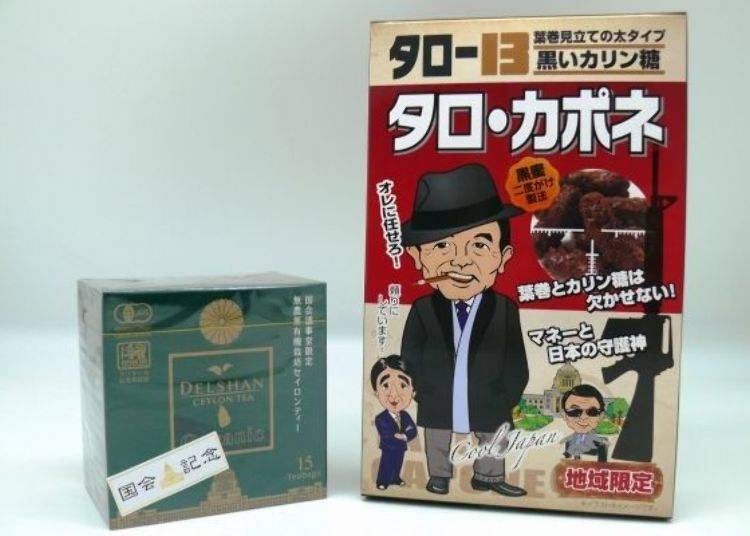
Truth be told, before our visit, we thought that having to tour the House of Representatives and the House of Councillors separately is a bit of a bother. However, actually going there and experiencing firsthand is a great reminder that this “bother of being separated” is the foundation of democracy – it is indispensable for proper checks and balances. Snacking on our crunchy karintō, we pondered about that, looking back on our tours of the National Diet Building.
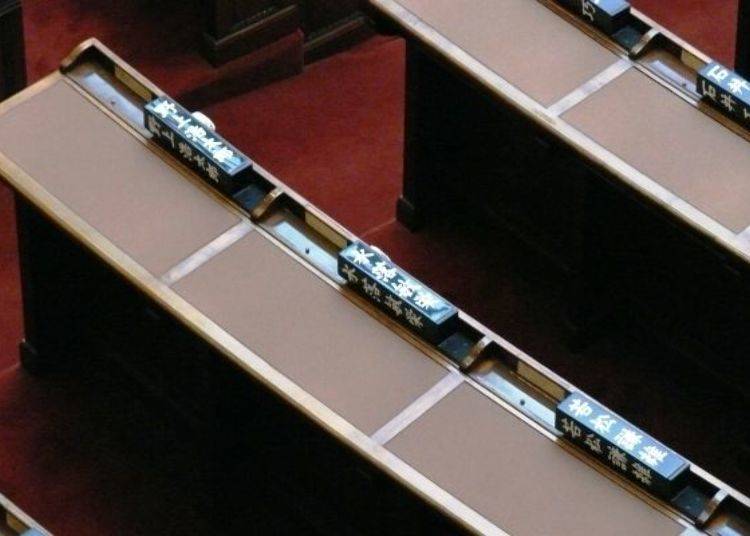
Last but not least: you can also watch a plenary session if you’re interested. Tickets are issued on the day of the session and in order of arrival. The House of Representative’s main sessions generally take place on Tuesdays, Thursdays, and Fridays from 1:00 p.m., while the House of Councillors’ sessions happen on Mondays, Wednesdays, and Fridays from 10:00 a.m. However, they may not be held every week, so be sure to check the official homepages on the morning of the day of your planned visit for an up-to-date schedule.
-
House of Representatives衆議院
- Address 1-7-1 Nagatachō, Chiyoda-ku, Tōkyō-to 100-0014
- Phone Number 03-3581-5111
Hours: Mondays to Fridays: 8:00 a.m. – 5:00 p.m.; tour every hour at half past
Saturdays and Sundays: 9:30 a.m., 10:30 a.m., 11:30 a.m., 1:00 p.m., 2:00 p.m., 5:00 p.m.; six tours a day
*On days with a plenary session, no admittance from one hour before the session’s opening until the end of the session.
Closed: open every day
Admission: free
Phone number for weekends and national holidays: 03-3581-0069
*Prices and options mentioned are subject to change.
*Unless stated otherwise, all prices include tax.
Popular Tours & Activitiess
-

Don't Miss Out! The One Thing You Must Do Before Shopping at Mitsui Shopping Park LaLaport: Get Your Max 10% OFF Coupon Book
-

Enjoy Japan's Gorgeous Winter Lights! Ride the Romancecar to Shonan no Hoseki Illumination
by: Guest Contributor
-

2025 Japan Autumn Color Report: Tokyo's Ginkgo Trees Starting to Glow
by: Timothy Sullivan
-

Get Ready to Catch 'Em All! First Ever Permanent Outdoor Pokémon Park Opening Near Tokyo!
-

LaLaport TOKYO-BAY North Building Now Open: Shop, Dine & Enjoy Events at LaLa arena, Just 2 Stops from Disney
by: Wemmy Chau
-

Black Friday 2025: These Are THE Japan Travel & Shopping Deals to Check Out
Inspiration for Accommodations
-

Enjoy Mt. Fuji from the Comfort of Your Room! Recommended Ryokan with Mt. Fuji View
-

Stay Near the Cherry Blossoms! Hotels for Cherry Blossom Viewing in Tokyo
-

Family-Friendly Hotels with Free Shuttle to Disneyland: Convenient Access for a Magical Stay
-

Top Ranked Hakone Hotels with Mt. Fuji View: Enjoy Stunning Scenery from Your Private Space
-

Convenient Tokyo Hotels with Airport Shuttle: Ideal for Families and Heavy Luggage
-

Stunning Tokyo Tower View Hotels: Enjoy Spectacular Scenery from Your Private Space
-

Convenient Asakusa Hotels with Kitchens: Ideal for Extended Family Visits
-

Experience Luxury: Hakone's 10 Best Five-Star Accommodations
-

Enjoy Mt. Fuji Autumn Leaves! Top Hotels Near the Popular Autumn Leaves Corridor
-

Experience Hakone Fall Foliage from Your Room with Stunning Views
-

8 Unfamiliar (But Totally Normal) Customs in Japan!
-

An In-depth Look at the Tokyo Tower One Piece Theme Park!
-

Tokyo Tower vs. Tokyo Skytree: Spice Up Your Sightseeing Adventure with Fun Trivia!
-

The Amazing Art and Architecture of Japan's Tokyo Station
-

Easy Day Trip from Tokyo! Ultimate Sightseeing Guide for Hakone & Lake Ashinoko!
-

Incredible Views of Tokyo: Inside Tokyo Tower's Top Deck Tour
- #best ramen tokyo
- #what to buy in ameyoko
- #what to bring to japan
- #new years in tokyo
- #best izakaya shinjuku
- #things to do tokyo
- #japanese nail trends
- #what to do in odaiba
- #onsen tattoo friendly tokyo
- #daiso
- #best sushi ginza
- #japanese convenience store snacks
- #best yakiniku shibuya
- #japanese fashion culture
- #best japanese soft drinks




















